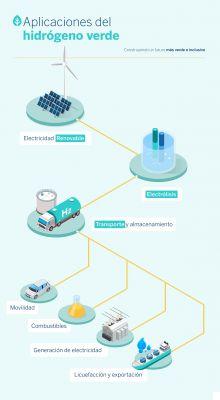
What is green hydrogen and why is it important?
Green hydrogen is a form of hydrogen produced from renewable energy, such as solar or wind power, and water. Unlike conventional hydrogen, which is obtained from fossil fuels, green hydrogen is a clean and sustainable source of energy.
Its importance lies in its potential to reduce greenhouse gas emissions and combat climate change. By using renewable energy in its production, green hydrogen does not emit carbon dioxide or other pollutants, making it a promising alternative for decarbonising key sectors such as transport and industry.
Uses and applications of green hydrogen
Green hydrogen has a wide range of uses and applications in various sectors. In transportation, it can be used as a fuel in fuel cell vehicles, offering a clean alternative to internal combustion vehicles. In industry, it can be used as a raw material for the production of chemical products and as a source of energy in industrial processes. Additionally, green hydrogen can be used to store renewable energy and offset intermittency from sources such as solar and wind power.
Challenges and solutions in the production of green hydrogen
Despite its benefits, green hydrogen production still faces significant challenges. One of the main challenges is the availability of large-scale renewable energy. To produce green hydrogen sustainably, a considerable amount of renewable energy is required, implying the need for adequate infrastructure and increased investment in clean energy.
Another challenge is the cost of production. Green hydrogen is currently more expensive to produce compared to conventional hydrogen. However, it is expected that as technology advances and economies of scale are achieved, costs will decrease and green hydrogen will become more competitive.
To overcome these challenges, it is necessary to foster collaboration between governments, companies and society in general. It is essential to promote policies and regulations that promote the transition towards a green hydrogen economy, as well as invest in research and development of more efficient and cheaper technologies.
Uruguay and its relationship with green hydrogen
Uruguay is a country that has shown great interest in the development of green hydrogen. Thanks to its abundant wind resource, the country has great potential for the production of renewable energy and therefore for the production of green hydrogen.
Currently, Uruguay has pilot projects for the production of green hydrogen and is working on the implementation of policies and regulations that encourage its development on a large scale. Furthermore, the country is promoting collaboration with other countries and international organizations to boost research and knowledge sharing in the field of green hydrogen.
Frequently Asked Questions (FAQs)
1. What is the difference between green hydrogen and conventional hydrogen?
The main difference between green hydrogen and conventional hydrogen lies in how it is produced. While conventional hydrogen is obtained from fossil fuels, such as natural gas, green hydrogen is produced from renewable energy and water. This makes green hydrogen a cleaner and more sustainable energy source, as it does not emit carbon dioxide or other pollutants during its production and use.
2. When is green hydrogen expected to be widely used?
While green hydrogen is still in an early stage of development, its use is expected to expand in the coming years. As technology advances and production costs fall, green hydrogen is expected to become more competitive and be used in key sectors such as transportation and industry. However, its large-scale adoption will depend on the availability of large-scale renewable energy and the implementation of policies and regulations that encourage its development.
Conclusion
Green hydrogen represents a sustainable and promising solution for the future. Its production from renewable energy and water makes it a clean and emission-free source of energy. Although it still faces challenges in terms of availability and cost, it is expected that as technology advances, green hydrogen will become a competitive alternative to fossil fuels. Uruguay, with its abundant wind resource, is positioned to lead the development of green hydrogen in the region. It is essential to promote collaboration and investment in this technology to achieve a successful transition towards a more sustainable and carbon-free economy.
We hope this article has been informative and helpful! If you have any questions or comments about green hydrogen, feel free to leave them below. We would love to hear your opinion and respond to your concerns.
Until next time!
The Pistonudos.com team


























